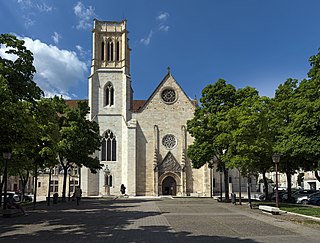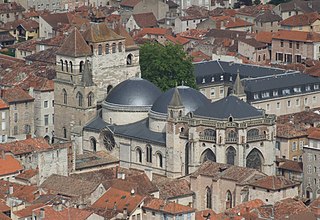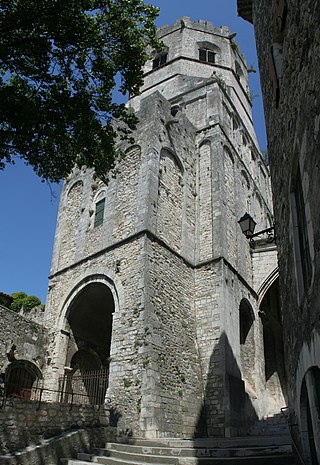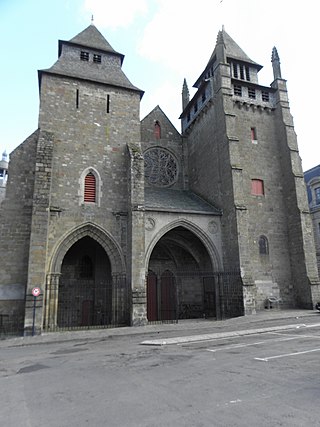
The Archdiocese of Bordeaux (–Bazas) is a Latin Church ecclesiastical territory or archdiocese of the Catholic Church in France. The episcopal see is Bordeaux, Aquitaine. It was established under the Concordat of 1802 by combining the ancient Diocese of Bordeaux with the greater part of the suppressed Diocese of Bazas. The Archdiocese of Bordeaux is a metropolitan see, with four suffragan dioceses in its ecclesiastical province: Dioceses of Agen, Aire and Dax, Bayonne, and Périgueux.

The Roman Catholic Diocese of Nice is a diocese of the Latin Church of the Roman Catholic Church in France. The diocese comprises the Départment of Alpes-Maritimes. The diocese is a suffragan of the Archdiocese of Marseille.

The Diocese of Agen is a Latin Church ecclesiastical territory or diocese of the Catholic Church in France.

The Roman Catholic Diocese of Cahors is a diocese of the Latin Church of the Roman Catholic Church in France. The diocese comprises the whole of the department of Lot.

The Diocese of Rodez (–Vabres) is a Latin Church ecclesiastical territory or diocese of the Catholic Church in France. The episcopal see is in Rodez. The diocese corresponds exactly to the Department of Aveyron.

The bishopric of Lavaur was founded by Pope John XXII in his plan to reorganize the sprawling diocese of Toulouse. The town is situated some fifteen miles to the east of Toulouse. Lavaur had the reputation of being one of the strongest centers of Catharism, being referred to as sedes Satanae, atque erroris haeretici primatica ('seat of Satan and prime source of heretical error' The diocese consisted of some 80–90 parishes. It hosted one abbey, that of Sorèz, a convent of the Clarisses, a convent of the Daughters of the Cross, a convent of Dominicans, one of Franciscans, one of Capuchins, two of reformed Dominicans, and two houses of the Doctrinaires. The diocese produced some 35,000 livres for the bishop.

The Roman Catholic Diocese of Viviers is a diocese of the Latin Church of the Roman Catholic Church in France. Erected in the 4th century, the diocese was restored in the Concordat of 1822, and comprises the department of Ardèche, in the Region of Rhône-Alpes. Currently the diocese is a suffragan of the Archdiocese of Lyon. Its current bishop is Jean-Louis Marie Balsa, appointed in 2015.

The former French Roman Catholic diocese of Agde existed from about the 6th century to the Concordat of 1801 between First Consul Napoleon Bonaparte and Pope Pius VII. Agde is in the south of France, in what is now the department of Hérault. The last bishop, Charles François de Rouvroy de Saint Simon Sandricourt, was guillotined in Paris on July 25, 1794.
The former French Catholic diocese of Alet was created in 1317 from territory formerly in the diocese of Narbonne. The diocese continued until the French Revolution when it was suppressed by the Concordat of 1801.

The former French Roman Catholic Diocese of Saint-Papoul, now a Latin titular see, was created by Pope John XXII in 1317 and existed until the Napoleonic Concordat of 1811.

The Roman Catholic Archdiocese of Poitiers is an archdiocese of the Latin Church of the Catholic Church in France. The archepiscopal see is in the city of Poitiers. The Diocese of Poitiers includes the two Departments of Vienne and Deux-Sèvres. The Concordat of 1802 added to the see besides the ancient Diocese of Poitiers a part of the Diocese of La Rochelle and Saintes.

The Archdiocese of Auch-Condom-Lectoure-Lombez, more commonly known as the Archdiocese of Auch, is a Latin Church ecclesiastical territory or archdiocese of the Catholic Church in France. The archdiocese now comprises the department of Gers in south-west France. The archdiocese is a suffragan of the Archdiocese of Toulouse, and the current bishop, who therefore does not wear the pallium, is Maurice Marcel Gardès, appointed in 2004.

The Diocese of Dax or Acqs was a Roman Catholic ecclesiastical territory in Gascony in south-west France. According to tradition it was established in the 5th century. It was suppressed after the French Revolution, by the Concordat of 1801 between First Consul Napoleon Bonaparte and Pope Pius VII. Its territory now belongs to the Diocese of Aire and Diocese of Bayonne.

The former Roman Catholic Diocese of Oloron was a Latin rite bishopric in Pyrénées-Atlantiques department, Aquitaine region of south-west France, from the 6th to the 19th century.

The Roman Catholic Diocese of Saint-Brieuc and Tréguier is a diocese of the Latin Church of the Roman Catholic Church in France. The diocese comprises the department of Côtes d'Armor in the Region of Brittany. The diocese is currently suffragan to the Archdiocese of Rennes, Dol, and Saint-Malo. The current bishop is Denis Moutel, appointed in 2010.

The Roman Catholic Diocese of Lescar, in south-western France, was founded in the fifth century, and continued until 1790. It was originally part of the Province of Novempopulania, and Lescar held the seventh place among the cities. Its see was the Cathedral of the Assumption in Lescar, begun in 1120; the crypt of the cathedral was also the mausoleum of the family of Albret in the 16th century.

The former French Catholic diocese of Apt, in southeast France, existed from the fourth century until the French Revolution. By the Concordat of 1801, it was suppressed, and its territory was divided between the diocese of Digne and the diocese of Avignon. Its seat was at Apt Cathedral, in Vaucluse.

The former French Catholic diocese of Grasse was founded in the 4th or 5th century as the diocese of Antibes. It was originally suffragan to the Archbishop of Aix, and then to the Archbishop of Embrun. The see moved from Antibes to Grasse in 1244. It remained at Grasse Cathedral until the French Revolution. The diocese was suppressed by the Concordat of 1801, its territory passing to the diocese of Nice.

The Roman Catholic Diocese of Pamiers, Couserans, and Mirepoix is a diocese of the Latin Church of the Roman Catholic Church in southern France. The diocese comprises the department of Ariège and is suffragan to the Archdiocese of Toulouse. The diocese of Pamiers is divided into five Deaneries: Pamiers, Foix, Haut-Ariège, Couserans, and Pays-d'Olmes-Mirapoix. The episcopal see is the Cathedral of Saint Antoninus in the city of Pamiers.

The Roman Catholic Diocese of Montauban is a diocese of the Latin Church of the Roman Catholic Church in France. The diocese is coextensive with Tarn-et-Garonne, and is currently a suffragan of the Archdiocese of Toulouse. The episcopal seat of the Diocese of Montauban is in Montauban Cathedral.



















